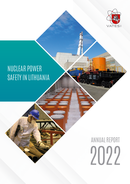The State Nuclear Power Safety Inspectorate (VATESI) has informed the International Atomic Energy Agency (IAEA) about a small amount of ruthenium-106 radionuclide (Ru-106) detected in Lithuania. During the period of 2-5 October, 2017 a low concentration (1.21 mBq/m³) of Ru-106 was found in the air filters of the Utena radiological measurement station. Such results were provided by the Lithuanian Environmental Protection Agency after measuring aerosol samples. The activity of traced radionuclide is very low and does not have any influence to human health.
At the beginning of October, several authorities in European countries reported an increased concentration of Ru-106 radionuclide in the air. The IAEA has requested member states to provide their radiological monitoring data in order to find out the tendencies and possible causes and circumstances of this radionuclide dispersion.
36 countries shared information on the results of radiological monitoring. According to the IAEA summary, the highest measurement of Ru-106 was reported in Romania, Bucharest (145 mBq/m³). However, the reason for the increase of Ru-106 concentration in the air and the precise location from which this radionuclide could have spread is difficult to determine because its quantities are very small. The possibility of an incident in a nuclear power plant is rejected as in that case other radionuclides would be released into the environment.
Ru-106 radionuclide is used in treatment of ocular and skin cancer.
VATESI is one of the Lithuanian authorities operating in the field of emergency preparedness. In such cases VATESI acts as a country's contact point – shares information from international bodies with other Lithuanian institutions, as well as provides information to international organizations about the situation in the country.







